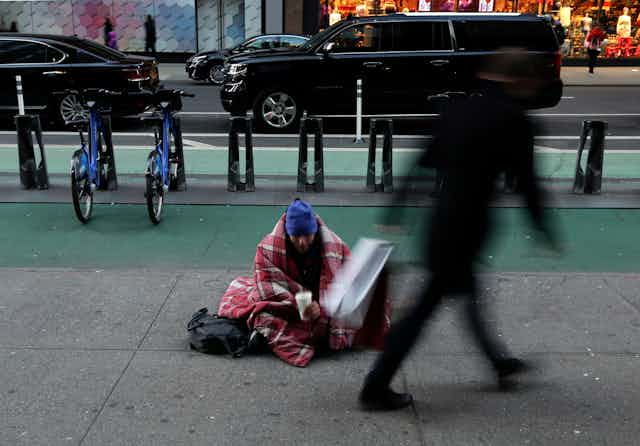Tonight, some 554,000 people in the U.S. will be homeless.
Many of them live on the West Coast, where Amazon CEO Jeff Bezos is launching a new fund that plans to fight the problem. Part of the US$2 billion donated by Bezos will be spent “to provide shelter and hunger support to address the immediate needs of young families.”
With such an enormous challenge, where would it make sense to start? We looked into our archives for stories on what it would take to eradicate homelessness in the U.S. today.
1. How the homeless population is changing
“The common perception of homelessness is that it is a problem that afflicts only those with mental health and substance use problems,” writes Margot Kushel, a professor of medicine at University of California, San Francisco. But a diverse array of Americans are affected.
In fact, the U.S. homeless population is getting older and sicker. Today, half is over the age of 50. Many of these older homeless adults are the victims of circumstance. “Their lives became derailed by job loss, illness, a new disability, the death of a loved one or an interaction with the criminal justice system,” writes Kushel.
2. Homeless high school students
Another group that struggles with homelessness: American teens. One in 30 high school students in the U.S. have experienced homelessness in the past year.
Research from Stacey Havlik at Villanova University shows “that school counselors often lack knowledge about students who are homeless, and have limited training to support their needs.” These students may need not only basic support like food and clothing, but extra attention to their mental health and planning for the future.
3. Better places to stay
About a quarter of homeless Americans are unsheltered. But even when there are shelters, people may choose not to go to them. Many are run-down and dirty, offer little privacy or feel unsafe.
Jill Pable at Florida State University suggests rethinking shelter design. Her team upgraded a local shelter with new features, like better lighting, privacy curtains and room to store possessions. “This small, only partially controlled study is not the final word in shelter design,” she writes, but the feedback from families who tried the new space was very positive.
4. Integrating homeless people into their communities
Another team in Connecticut helps people with mental illness and criminal histories, many of whom have experienced homelessness, by teaching them about citizenship. The Citizens Project in New Haven is an intervention program that teaches people how to participate in their community, with classes on topics like conflict resolution and public speaking. Afterwards, participants report better quality of life, less substance abuse and fewer criminal charges.
“The people we worked with needed to see themselves – and be seen as – full members of their neighborhoods and communities,” write program creators Michael Rowe of Yale University and Charles Barber of Wesleyan University. “They needed, in other words, to be citizens.”
Editor’s note: This story is a roundup of articles from The Conversation’s archives.

